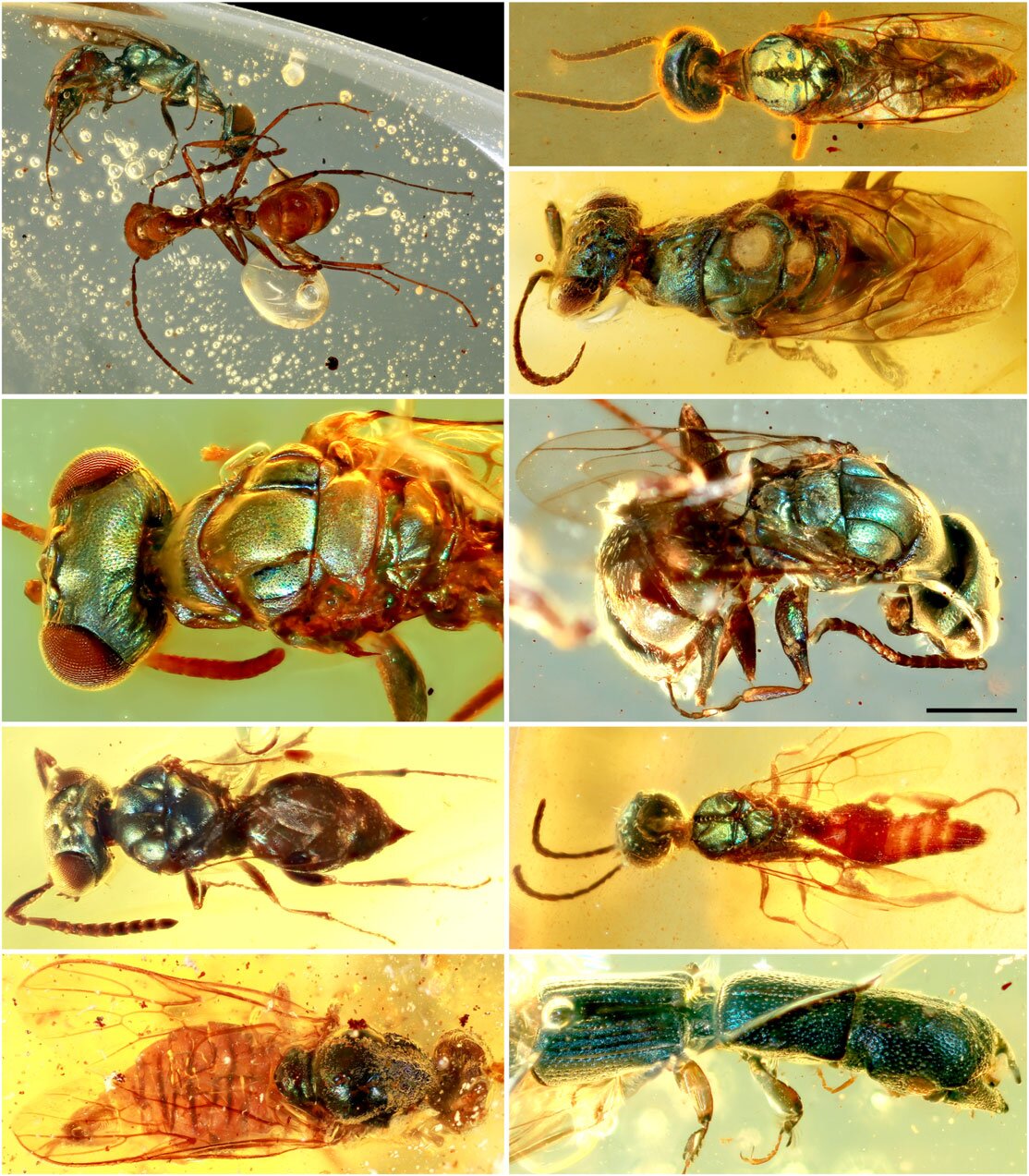

Various insects of structural color in the mid-cretaceous amber of northern Myanmar. Credit: NIGPAS
Nature is full of colors, from the radiant glow of a peacock’s feathers or the bright warning coloration of toxic frogs to the pearl-white camouflage of polar bears.
Typically, the fine structural details required for color preservation are seldom preserved in the fossil record, making most fossil reconstructions dependent on an artist’s imagination.
A research team from the Nanjing Institute of Geology and Paleontology at the Chinese Academy of Sciences (NIGPAS) has now revealed the secrets to true coloration in 99 million-year-old insects.
Colors offer many clues to the behavior and ecology of animals. They work to keep organisms safe from predators, at the right temperature, or attractive to potential mates. Understanding the coloration of long-extinct animals can help us shed light on ecosystems in the deep geological past.
The study, published in Proceedings of the Royal Society B July 1 offers a new perspective on the lives of insects that are often overlooked, but by no means boring, that coexisted alongside dinosaurs in the Cretaceous rain forests.
The researchers assembled a treasure trove of 35 pieces of amber with exquisitely preserved insects from an amber mine in northern Myanmar.

Comparisons between original and altered metallic colors in cleptin wasps. Credit: NIGPAS
“Amber is from the Middle Cretaceous, approximately 99 million years old, and dates back to the golden age of dinosaurs. It is essentially resin produced by ancient coniferous trees that grew up in a rainforest environment. Animals and plants trapped in the thick resin was preserved, some with real fidelity, “said Dr. Cai Chenyang, NIGPAS associate professor who led the study.
The rare set of amber fossils includes cuckoo wasps with teal, yellowish green, purple blue, or green metallic colors to the head, thorax, abdomen, and legs. In terms of color, they are almost the same as the cuckoo wasps that live today, Dr. Cai said.
The researchers also discovered samples of blue and purple beetles and a dark green metallic soldier fly. “We have seen thousands of amber fossils, but color preservation in these specimens is extraordinary,” said Professor Huang Diying of NIGPAS, co-author of the study.
“The type of color preserved in amber fossils is called structural color. It is caused by the microscopic structure of the animal’s surface. The surface nanostructure scatters light of specific wavelengths and produces very intense colors. This mechanism is responsible of many of the colors we use. Know about our daily lives, “explained Professor Pan Yanhong of NIGPAS, a paleocolor reconstruction specialist.
To understand how and why color is preserved in some amber fossils but not others, and if the colors seen in fossils are the same as insects paraded more than 99 million years ago, researchers used razor blades. diamond to cut exoskeleton of two of the colorful amber wasps and a sample of normal opaque cuticle.
Using electron microscopy, they were able to demonstrate that the colorful amber fossils have a well-preserved exoskeleton nanostructure that scatters light. The unaltered nanostructure of colored insects suggested that the colors conserved in amber may be the same as those shown in the Cretaceous. But in fossils that do not retain color, the cuticular structures are badly damaged, which explains their brown-black appearance.
What kind of information can we learn about the life of ancient insects from their color?
Existing cuckoo wasps are, as the name implies, parasites that lay their eggs in the nests of unrelated bees and wasps. Structural coloration has been shown to serve as camouflage for insects, so the color of the cretaceous cuckoo wasps likely represented an adaptation to avoid detection. “At the moment, we cannot rule out the possibility of colors playing other roles besides camouflage, such as thermoregulation,” adds Dr. Cai.
Amber specimens reveal the origin of the long mouthpart of scorpion flies
Structural colors in various mesozoic insects, Proceedings of the Royal Society B (2020). rspb.royalsocietypublishing.or… .1098 / rspb.2020.0301
Provided by the Chinese Academy of Sciences
Citation: Amber Fossils Unlock True Color of Insects 99 Million Years Old (2020, June 30) Retrieved June 30, 2020 from https://phys.org/news/2020-06-amber-fossils- true-million-year- old-insects.html
This document is subject to copyright. Other than fair dealing for private research or study purposes, no part may be reproduced without written permission. The content is provided for informational purposes only.